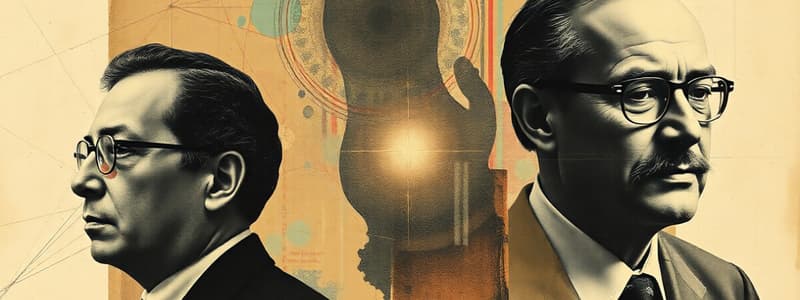Podcast
Questions and Answers
What was the primary scientific contribution of Vera Rubin to the field of astronomy?
What was the primary scientific contribution of Vera Rubin to the field of astronomy?
- Invention of the radio telescope
- The discovery of black holes
- Development of the theory of relativity
- Confirmation of the presence of dark matter (correct)
How did Peter Higgs contribute to the understanding of particle physics?
How did Peter Higgs contribute to the understanding of particle physics?
- By explaining the mass of elementary particles through the Higgs field (correct)
- By postulating the existence of parallel universes
- By developing the theory of electroweak interaction
- By inventing the first particle accelerator
What Nobel Prize-winning research did Eric Kandel conduct on a particular organism?
What Nobel Prize-winning research did Eric Kandel conduct on a particular organism?
- Analysis of bacteria in antibiotic resistance
- Experiments on mice to explore DNA replication
- Research on Drosophila in genetic mutation
- Studies on sea slug to understand memory (correct)
What significant environmental issue did Mario J. Molina address with his research?
What significant environmental issue did Mario J. Molina address with his research?
Which scientific field was significantly advanced by Donna Strickland's research?
Which scientific field was significantly advanced by Donna Strickland's research?
What was the main focus of Carol Greider's Nobel Prize-winning research?
What was the main focus of Carol Greider's Nobel Prize-winning research?
For what scientific breakthrough did Abdus Salam receive the Nobel Prize in Physics?
For what scientific breakthrough did Abdus Salam receive the Nobel Prize in Physics?
Which medical condition did Lap-Chee Tsui's genetic research specifically target?
Which medical condition did Lap-Chee Tsui's genetic research specifically target?
What was the groundbreaking achievement of Mae Carol Jemison in space exploration?
What was the groundbreaking achievement of Mae Carol Jemison in space exploration?
Which scientific phenomenon did Vera Rubin's observations challenge?
Which scientific phenomenon did Vera Rubin's observations challenge?
Flashcards
Abdus Salam
Abdus Salam
Proposed the electroweak theory unifying weak interaction and electromagnetism.
Vera Rubin
Vera Rubin
Discovered the existence of dark matter through galaxy rotation speeds.
Peter Higgs
Peter Higgs
Developed Higgs field theory explaining the mass of particles.
Eric Kandel
Eric Kandel
Signup and view all the flashcards
Mario J. Molina
Mario J. Molina
Signup and view all the flashcards
Lap-Chee Tsui
Lap-Chee Tsui
Signup and view all the flashcards
Mae Carol Jemison
Mae Carol Jemison
Signup and view all the flashcards
Donna Strickland
Donna Strickland
Signup and view all the flashcards
Carol Greider
Carol Greider
Signup and view all the flashcards
Higgs Boson
Higgs Boson
Signup and view all the flashcards
Study Notes
Abdus Salam (1926-1996)
- Born in Pakistan, studied mathematics and physics at the University of Cambridge.
- Proposed the electroweak theory, explaining weak interaction between subatomic particles and unification with the electromagnetic force.
- Postulated messenger particles for weak interaction.
- Theories verified at CERN (European Organization for Nuclear Research) in 1973.
- Jointly awarded the Nobel Prize in Physics in 1979 with Sheldon Lee Glashow and Steven Weinberg.
Vera Rubin (1928-2016)
- Discovered that stars in outer regions of spiral galaxies move as fast as those closer to the center, contradicting Newton's laws of gravity.
- Implied the existence of dark matter within galaxies.
- Concluded dark matter was a general phenomenon confirming her observations with 60 spiral galaxies, receiving the National Medal of Science in 1993.
Peter Higgs (1929-)
- Born in Newcastle, England, studied physics at King's College London and University of Edinburgh.
- Developed theory explaining the origin of mass for subatomic particles.
- Proposed the Higgs field that permeates space and interacts with particles to give them mass.
- Predicted a field particle called the Higgs boson.
- Higgs boson discovered in 2012 at CERN, confirming the theory.
- Jointly awarded the Nobel Prize in Physics in 2013 with François Englert.
Eric Kandel (1929-)
- Born in Vienna, fled to the US due to antisemitism.
- Studied medicine at New York University, graduating in 1956.
- Awarded the Nobel Prize in Physiology or Medicine in 2000 for research on how synapses (nerve connections) affect memory and learning, focusing on sea slugs.
Mario J. Molina (1943-)
- Born in Mexico City, became a chemical engineer.
- Collaborated with Sherwood Rowland.
- Discovered that CFCs (chlorofluorocarbons) destroy the ozone layer, leading to the Nobel Prize in Chemistry in 1995.
Lap-Chee Tsui (1950-)
- Canadian medical geneticist born in Shanghai.
- Moved to Canada in 1977.
- Jointly discovered the gene responsible for cystic fibrosis, a life-threatening disease.
- Pioneered new treatment options based on identifying the faulty gene or replacing it.
Mae Carol Jemison (1956-)
- First African American woman to travel in space.
- Served as a science mission specialist on the Space Shuttle Endeavour in 1992.
- Graduated from medical school in 1981, before serving as a medical officer with the Peace Corps.
Donna Strickland (1959-)
- Canadian optical physicist, developed chirped pulse amplification (CPA), a technique for producing extremely short and intense laser pulses.
- Jointly awarded the Nobel Prize in Physics (2018) with Gérard Mourou.
- Now leads the ultrafast laser research team at the University of Waterloo.
Carol Greider (1961-)
- American molecular biologist. Known for research on telomeres and the enzyme telomerase.
- Telomeres are DNA segments that protect the ends of chromosomes and play a role in cell life span.
- Awarded the Nobel Prize in Physiology or Medicine in 2009 along with Elizabeth Blackburn and Jack W. Szostak for discovering that inhibiting telomerase slows tumor growth.
Studying That Suits You
Use AI to generate personalized quizzes and flashcards to suit your learning preferences.




